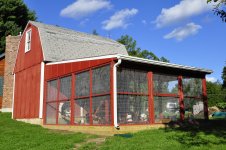jenkinsph
Super Star Member
Just one of the reasons I moved away from Louisiana to the desert southwest. The humidity in New Orleans was too much for me, best thing I did was get out of there. I do miss the food and my old friends though.

The venting idea is sound but the reasoning, as stated, isn't. You are not trying to lower humidity with ventilation. You are trying to balance temperatures. If OP's tractor or metal object was outside I'm gathering he does not believe it would form condensation. The reason is because the temperature of the object is rising at or near the same speed as the air.....no condensation.
Move that object inside the barn and things are different. The solar gain on the structure heats the air inside the structure faster than the object (which receives no solar gain). When this occurs the object will form condensation from the temperature difference between the air and object.
The goal with moving air (mechanical or natural venting) is to mitigate the solar gain which will slow the warming process inside.
So, beyond the big ticket obvious exterior moisture issues like proper drainage around the structure, the goal is to slow temperature change. If the goal is to lower RH the OP needs to seal the structure and mechanically remove moisture.
Thoughts on a solution-
With an insulated structure this could go either way. Vent or not vent. It's time to experiment.
First air the place out to balance RH between inside and outside. Then leave 2 roll up doors on opposite sides up overnight and see if condensation forms. If not, continue to lower the doors daily until it does. This will give you an idea how much venting you will need. Assuming you don't have a good predominate wind from a different direction. The vent sizing can be slightly less if you are using the low and high venting suggested by a few folks as this creates some natural convection.
However, I'd also try this since it's insulated. Maybe the insulation can slow the temperature change enough that having the holes in the doors is the issue. In this scenario the goal would be to make the structure as air tight as possible. To do this the starting point is the same with airing the structure out to balance the RH. Then seal up the openings in the roll up doors and any other major sources of air infiltration. See what happens the next day. Maybe, just maybe, the insulation is slowing the temperature changes enough to prevent condensation.
Both of these experiments will cost little to nothing except some time. If objects outside aren't condensating but objects inside still are with doors fully open or everything sealed then it would be time to think about a fan on a switch that is reading temperature differences.
Questioning the balancing the temp issue. I have a chicken run as a lean to off one side of a large shed. The roof is metal and the sides are open but have fencing to keep the chickens in, predators out. I get condensation all the time on the metal roof. Since the sides are open, the temp inside is the same as the outside temp. So I don't have a venting problem or an unequal temp problem. But I get wet roof many mornings.
View attachment 493670
My experience with this metal roof is causing me to shy away from a larger lean to off my barn that I will use for equipment storage - camping trailer, 6x10 trailer, car transport trailer plus zero turn, lawn tractor and wood splitter. I don't want water dripping down causing rust on the equipment. Seems plywood and asphalt shingles don't have this issue.
The metal holds the overnight temp longer than the ambient air as it's displacement is heavier, requiring more energy to heat and adequate convection heating in this case, for it hasn't occurred. It's cooler than ambient air, moisture in the air condenses on the cooler surface. As I said, I have the same problem with the leanto on my shop.
Another example is the air conditioner. Cold evaporator coils collect the moisture passing over them since they are colder than the air. The moisture doesn't collect on objects in the room as they are warmer than the air being refrigerated. If you have a glass of iced tea on the table, it will condense the water in the air adjacent to it as it is colder like the cooling coils. Had there been no moisture in the air it wouldn't/couldn't sweat.
You should avoid a metal roof exposed on the inside. Glue/spray a thin layer of insulation inside and a metal roof should do fine. Like slipping a cold pop can into a koozie.The problem I have is the humidity all winter long in CT is 60-100%. Right now it is 30 out with 89% humidity. Heating the equipment shed is not an option. So should I avoid a metal roof knowing I don't want condensation dripping on everything? The inside of my barn never has the condensation issue, it is a typical New England barn built of wood in the 1800's.